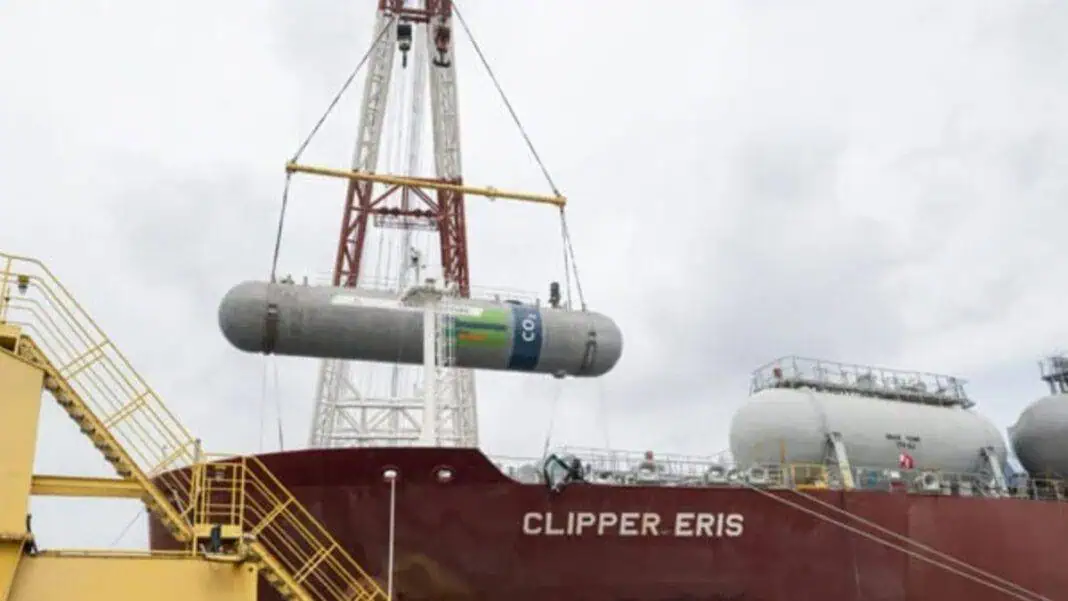The world’s first ship with a full-scale Onboard Carbon Capture & Storage facility is ready for pilot testing. Solvang ASA hopes this technology becomes a milestone for the world’s trading fleet on route to zero emissions.
“Onboard carbon capture combined with existing cleaning technology is a significant shortcut to decarbonization of the world’s deep-sea fleet. This stands out as one of the more promising solutions for future vessels”, says Edvin Endresen, CEO of Solvang ASA.
The ship Clipper Eris – owned by Solvang ASA – is the first to be installed with technology for “Onboard Carbon Capture & Storage” (OCCS). With OCCS, the exhaust is cleaned, reducing CO2 emissions by up to 70 per cent, before it is stored in deck tanks for discharge to sequestration or usage.
This pilot project is a collaboration effort between Solvang, technology provider Wärtsilä, MAN Energy Solutions, and the research institute SINTEF. Solvang has seven new vessels under construction, all designed and ready for installation of Onboard Carbon Capture & Storage technology.
“The introduction of carbon capture and storage capabilities on board the Clipper Eris is a major leap forward for maritime sustainability. It represents a system change that has been made possible by close collaboration between our companies. We at Wärtsilä are proud to be helping shape the decarbonization of the marine industry, and we congratulate Solvang for their vision and support in making this breakthrough possible,” says Roger Holm, President of Wärtsilä Marine.
Over the past few months, Clipper Eris has been in dry dock for a full retrofit. Equipped with the new OCCS technology, it is now ready for far stricter environmental requirements in the future. The project team is in Singapore on January 16th to present the Clipper Eris currently in Seatrium Admiralty Yard.
Launching the pilot testing is an important milestone in this project. For Onboard Carbon Capture & Storage to be a success on a larger scale, more shipping companies and industry stakeholders must see the benefits and join in.
Solvang CEO Edvin Endresen points out two key factors for succeeding with OCCS technology in shipping: Infrastructure and global regulations.
“CO2 can be recycled and used in land-based industries, but the global infrastructure for discharge for shipping needs to be developed fast. In addition, IMO must implement global regulations with benefits and penalty schemes for achieving the set goals. Predictability is necessary for the industry to invest in solutions for reducing CO2 emissions,” says Edvin Endresen.
The world’s 70,000 merchant ships, mostly run by fossil fuel, account for up to 3% of the world’s fossil CO2 emissions.
For over a decade, the International Organization (IMO) has enforced regulatory action to cutgreenhouse gases (GHG) from shipping, but the industry has struggled to adapt successfully. Hence, IMO revised their GHG strategy in 2023 to improve energy efficiency and increase use of net-zero emission fuels. The target is to be net-zero emission fuels by 2050.
There are two main paths to this goal: Changing to lower emission fuel or using conventional fuel and cleaning the exhaust.
Handling CO2 has been the challenge with the latter solution – but now things look brighter: Solvang believes the capture of CO2 on board ships is one of the most promising paths to netzero emissions in the future.
The Norwegian shipping company received funding from the Norwegian State, through Enova, in 2023, making it possible to start the pilot project with Clipper Eris. As the pilot testing now starts, the shipping industry is watching closely.












